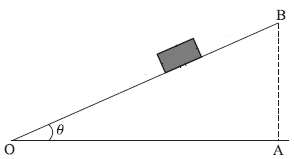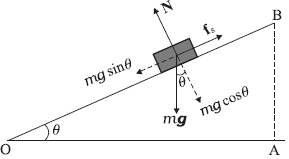A mass of $4\; kg$ rests on a horizontal plane. The plane is gradually inclined until at an angle $\theta= 15^o$ with the horizontal, the mass just begins to slide. What is the coefficient of static friction between the block and the surface ?

A mass of $4\; kg$ rests on a horizontal plane. The plane is gradually inclined until at an angle $\theta= 15^o$ with the horizontal, the mass just begins to slide. What is the coefficient of static friction between the block and the surface ?

Answer The forces acting on a block of mass $m$ at rest on an inclined plane are $(i)$ the weight mg acting vertically downwards $(ii)$ the normal force $N$ of the plane on the block, and $(iii)$ the static frictional force $f_{ s }$ opposing the impending motion. In equilibrium, the resultant of these forces must be zero. Resolving the weight $m g$ along the two directions shown, we have
$m g \sin \theta=f_{s}, \quad m g \cos \theta=N$
As $\theta$ increases, the self-adjusting frictional force
$f_{ s }$ increases until at $\theta=\theta_{\max ^{\prime}} f_{ s }$ achieves its
maximum value, $\left(f_{s}\right)_{\max }=\mu_{s} N$
Therefore.
$\tan \theta_{\max }=\mu_{s}$ or $\theta_{\max }=\tan ^{-1} \mu_{s}$
When $\theta$ becomes Just a little more than $\theta_{\max }$. there is a small net force on the block and it begins to slide. Note that $\theta_{\max }$ depends only on
$\mu_{ s }$ and $1 s$ independent of the mass of the block.
For $\quad \theta_{\max }=15^{\circ}$
$\mu_{s}=\tan 15^{\circ}$
$=0.27$

Similar Questions
In figure, the coefficient of friction between the floor and the block $B$ is $0.2$ and between blocks $A$ and $B$ is $0.3$. ........ $N$ is the maximum horizontal force $F$ can be applied to the block $B$ so that both blocks move together .
In figure, the coefficient of friction between the floor and the block $B$ is $0.2$ and between blocks $A$ and $B$ is $0.3$. ........ $N$ is the maximum horizontal force $F$ can be applied to the block $B$ so that both blocks move together .
Which of the following is self adjusting in nature?
Which of the following is self adjusting in nature?
A board is balanced on a rough horizontal semicircular log. Equilibrium is obtained with the help of addition of a weight to one of the ends of the board when the board makes an angle $\theta$ with the horizontal. Coefficient of friction between the log and the board is
The limiting value of static friction between two contact surfaces is ...........
The limiting value of static friction between two contact surfaces is ...........
A block of mass $4\,kg$ is placed on a rough horizontal plane A time dependent force $F = kt^2$ acts on the block, where $k = 2\,N/s^2$. Coefficient of friction $\mu = 0.8$. Force of friction between block and the plane at $t = 2\,s$ is ....... $N$
A block of mass $4\,kg$ is placed on a rough horizontal plane A time dependent force $F = kt^2$ acts on the block, where $k = 2\,N/s^2$. Coefficient of friction $\mu = 0.8$. Force of friction between block and the plane at $t = 2\,s$ is ....... $N$


